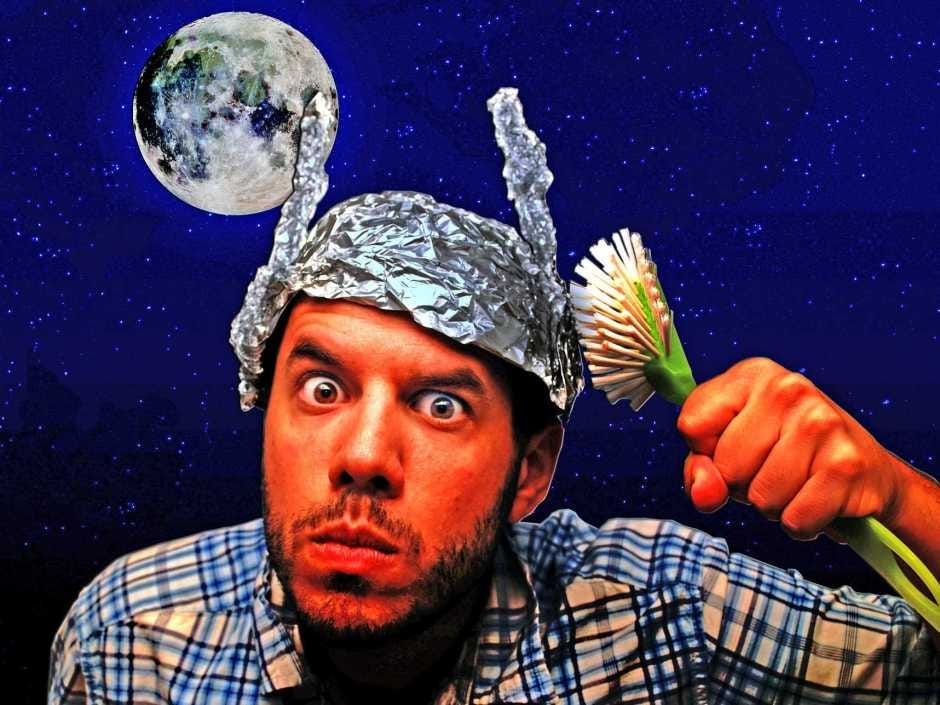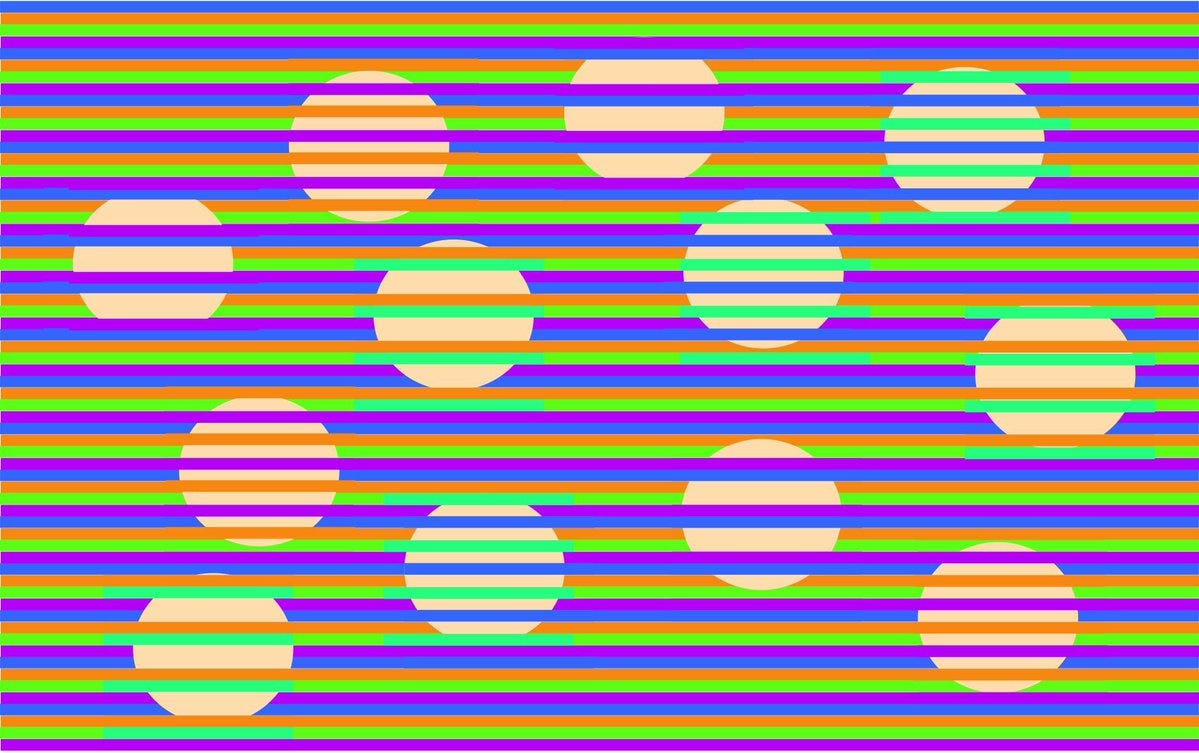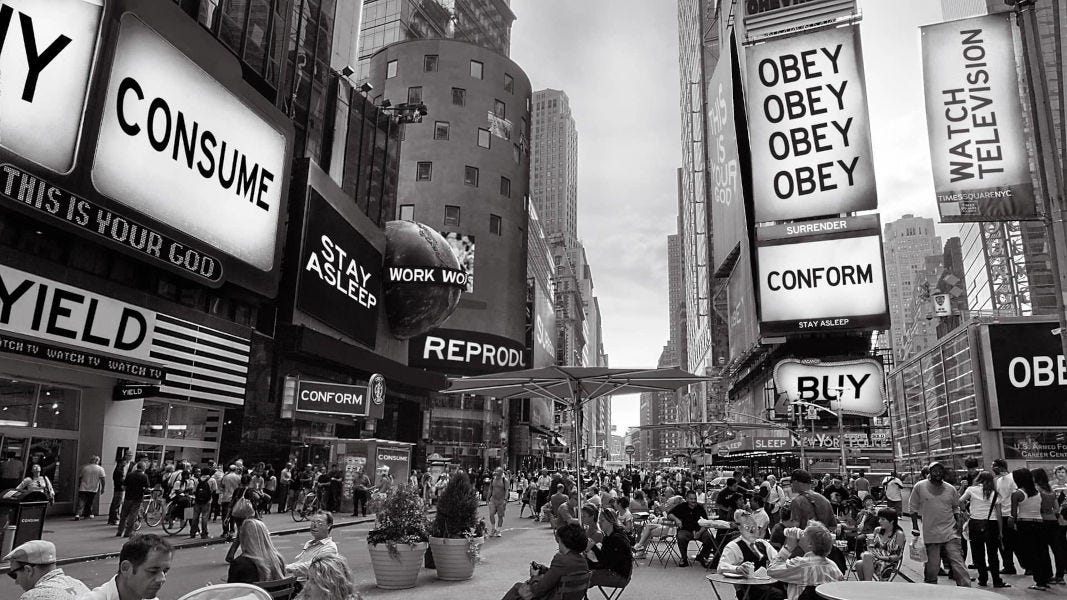Spook Central (Part Three)
Artificial intelligence, stochastic resonance and the Internet of Things are making the unseen worlds more visible. Now what?
Part One: Introduction; The Dust Collection; the New Deluge
Part Two: The Server Tower of Babel; Man of the Margins
The Goldilocks Threshold
At the end of Part Three, I posited “stochastic resonance” as an explanation for why some observers are able to see through certain illusions. Wikipedia defines it as follows:
Stochastic resonance (SR) is a phenomenon in which a signal that is normally too weak to be detected by a sensor can be boosted by adding white noise to the signal, which contains a wide spectrum of frequencies. The frequencies in the white noise corresponding to the original signal's frequencies will resonate with each other, amplifying the original signal while not amplifying the rest of the white noise – thereby increasing the signal-to-noise ratio, which makes the original signal more prominent. Further, the added white noise can be enough to be detectable by the sensor, which can then filter it out to effectively detect the original, previously undetectable signal.
This phenomenon of boosting undetectable signals by resonating with added white noise extends to many other systems – whether electromagnetic, physical or biological – and is an active area of research.
There’s a bunch of hard math involved. But in terms of human perception, the SR process can be described as making a signal more detectable by adding signals of equal intensity but “random” frequency (i.e. white noise).

The power spectral density of the additive noise remains constant over the window of time it’s applied, but the frequencies themselves are perceived as uninterpretable nonsense or garbage by our conscious minds. Add too much noise to an otherwise interpretable signal (e.g. a picture, a song) and that signal will lose coherence in your mind, like Roy Batty’s “tears in rain.”
The measurable SR effect stipulates that there is a “sweet spot” for additive noise, however, which paradoxically makes a normally undetectable signal observable. Once the threshold is met, an invisible signal takes on a recognizable shape in the observer’s subtle meta-organs (e.g. the mind’s eyes and ears). The clarity of that shape will depend on other factors, including the observer’s own repository of experiences and mental faculties. But in all cases, the “ghost” signal will materialize from the ether, cohering into a recognizable pattern of some kind. This optimizing threshold is similar to Goldilocks and her porridge; not too hot, not too cold. Just right.
A simple explanation of the effect might be the heightened contrast between a signal that’s designed to be intelligible versus signals that aren’t. But the most important thing to note about the stochastic resonance effect is that it has been reproduced across multiple mediums and domains. It’s one of those phenomena that is widely accepted as “real”, but the mechanics of which aren’t adequately explained.
As usual, current research tends to invert causality (i.e. it focuses on effects like gamma oscillations in the neuron, assuming this to be the cause). That’s why the answer will never be understood using their reductive methods; under the spell of Left hemisphere abstract thinking, they’ve drawn the problem upside-down. In fact, I expect the phenomenon won’t ever be “understood” in the scientific sense, because the primary dataset is located across the hard boundary of consciousness, and all measurable effects run downstream from that invisible source.
That doesn’t mean all of their research is useless. For example, in the field of neural research, the SR phenomenon has been studied as pertains to the subject’s response to subliminal imagery: so-called “hidden” words and images that fall short of the signal-to-noise threshold we associate with conscious detection.
The incorporation of subliminal sounds and pictures have deep roots in occult philosophy and practice, which we will examine in a later chapter. For now, I’ll stipulate that when we encounter these kinds of signals in our mass electronic mediums, they include similar elements of deception, being designed to be incompletely or incorrectly decoded by most receivers. Some might even be inversely encoded, akin to the “Satanic message” on the record playing backwards. But regardless of the encoding technique, the transmission will leave behind some blurry fingerprints of the true signal, in the hopes of gradually conditioning the observer.
Subliminal messaging is an occult technology that every person alive today has been subjected to, in the forms of advertising, entertainment, news broadcasts, and political messaging. But we might as well bundle these signaling formats into the term “propaganda”, because they all pertain to signals that are designed to strategically deceive. Common designs in the consumer sector lead to the subtle inception of words, pictures, logos, symbols, slogans, and suggested actions that quietly guide the observer down the sales funnel.
Like hypnosis, these pseudoscientific methods have been in play for a very long time. While individual practitioners like Edward Bernays or groups like the Freemasons are often cited as their inventors/authors, they simply added new technical innovations to a signaling technique that’s probably untraceably ancient. The signals themselves may be superficially “benign” in the sense that the encoded suggestion doesn’t lead directly to harm. On the other hand, some harms are only detectible over very long timescales, and concurrent with other harmful signals that support it.

The current state and growth rate of our Internet signal economy implies that these covert signals have also exploded in number and complexity within a short period of time, with fewer and fewer barriers to reception. But we’ve also been experiencing an attendant spike in “random” noise (which, as we’ll explore later on, isn’t truly random, because nothing is).
Bearing in mind the apparent universality of stochastic resonance (and warily eyeing the schizophrenia market for short sellers), I propose the following explanation for one aspect of the thinning Veil, and perhaps for the “Clownworld” so many observers now describe.
As a civilization and as individuals, we are currently living at or near the Goldilocks Threshold of stochastic resonance. Before the rise of global networks, the signals were too weak for most observers to detect and interpret them in liminal space. But we have now reached a kind of “sweet spot” for the mean observer. Signals that were invisibly weak or encrypted before are now ringing loud and clear for greater and greater masses of observers.
This is also the reason that so much of what we’re seeing now strikes us as hilariously absurd, and what is provoking such extreme and paranoid reactions from the signal designers and their paymasters. It’s the reaction of the Invisible Man, suddenly finding himself nude and fully visible in the public square. If only one person could see him, such an apparition might instead horrify, and cause the witness to question her own sanity. But when a large enough fraction of the population can see through an illusion, an avalanche of comedy may ensue.
It’s worth noting that some of us have always been able to extract truths from weaker signals, and parsed from what normally would be an insufficient level of noise. In that sense, the “Goldilocks threshold” is different for each observer, with a variance that may be linked to a wide range of factors.
That said, signal extraction for low-threshold observers can be dangerous.
For example, there’s a good reason that stochastic resonant vision correlates strongly with mental illness diagnosis. When the noise is too weak to clarify hidden signals for the general population, the individual who Sees Through The Lies™ is going to sound like a lunatic in most settings. Worse, they may even become one, gradually driven insane by a near-constant barrage of fully decoded illusions that no one else can detect. This has implications for seeing “spooks” as well. But even exposure to decrypted signals in everyday media might degrade someone’s sanity over time.
These onsets of (obvious) mental illness helped reinforce a a broader cultural marginalization of anyone who demonstrated this extraction ability (or curse, depending on the individual and environment). Even if you just happened to notice something “off” about a given signal, you were discouraged from talking about it openly, lest you be accused of being a “conspiracy theorist” and advised to “take off the tin foil hat.”
Another danger has to do with moral insanity: If you are one of those observers who can extract weak signals at low-thresholds, it’s not a given that you’ll run off gibbering into the streets, or climb onto some hamster wheel of antipsychotics and other head-meds. You may instead decide to see this ability as a “gift”, and participate in the seller’s side of the market. You wouldn’t be short of opportunities to apply it, either. Your gift is very much in demand, for a variety of industries and employers.
In 2015, Balenciaga’s creative vision was handed over to it’s current director, a Georgian designer by the name of Demna Gvasalia (or simply “Demna,” in the style of “Cher” or “Madonna”). A refugee from the 1992 Russo-Georgian War, he eventually landed at the Belgian Royal Academy of Fine Arts, where he graduated with a Master's degree in Fashion Design in 2006. By 2014, Demna and his brother Guram gained notoriety for selling their designs in Parisian gay sex clubs, and had started their own fashion label. As a celebrated fashionista, Demna has led the way on the house’s brand identity ever since, including into its current slime pit of allegations regarding child pornography, sexual abuse, financial exploitation and — yes — ad campaigns featuring a shitload of Satanic imagery (see below).
But the question remains: Why are some minds able to parse these encoded/occulted signals more or less immediately, even when we aren’t prompted to look for them? Is this form of true reception/decoding due to an inherent ability or biologic trait? Or is it more the product of experiences and insights that accumulate over time?
And more importantly for our purposes: Is the stochastic resonance decryption process opaque to the observers themselves, or is it something that can be proceduralized and taught to others?
The reason this is so critically important pertains to anther sentiment you’ll hear expressed a lot these days. To paraphrase it: “It seems like we’ve been handed the opportunity of a lifetime.” That’s the glass half-full version, anyway. But it’s tempered by the sense that the window of opportunity is already starting to close, or will be soon enough.
That’s because random noise — or nonsense — generation isn’t slowing down. If anything, it’s accelerating. Unfortunately, that means the masses of people who can see true signals clearly at the moment might become blind to them again in a year, a month, a week. They will go from Naked Emperor-spotting to “Tears in rain.”
Because of this, we can’t rely on autonomic SR-vision alone. We need to better understand the phenomenon, and develop techniques that can add or subtract noise as necessary on-the-fly
The Magic Sunglasses
In John Carpenter’s 1988 sci-fi/horror film They Live, the sensory and decoding procedures were localized to a piece of external technology. I usually refer to these fictional devices as “magic sunglasses” in the sense that Arthur C. Clarke conceived of magic:
“Any sufficiently advanced technology is indistinguishable from magic.”
They remain magical devices to the film’s heroes as well, absent any jargon to describe how they function. Nor is there any skill involved with this decryption method: you just put them on, and can instantly parse the signals hidden in the noise. If we were to posit stochastic resonance as the mechanism, then what the glasses might do is add or subtract just enough noise for the wearer to consciously receive the signal and decode it.
Various tools and mathematical techniques have been devised to emulate this phenomenon under laboratory conditions. But the lab is not the wild. How is the decoding accomplished in the latter space, without the assistance of external tools or carefully designed experiments? Out here in the messy real world, our evidence of “true seeing” is almost wholly anecdotal.
In that spirit, here’s an anecdote:
Around fifteen years ago, my wife and I were invited to a party. A couple we knew were housesitting for some friends of theirs, and decided to have a small get together in what was, to me, a massive condo apartment. The couple who lived there included a magazine editor and a successful painter. I’m not sure which of their incomes paid the lion’s share, but the painter’s unsold works were hanged on just about every wall.
Anyway, we’d just arrived and joined a small group of people, which included our housesitting friends. They were gathered around a pair of huge paintings that depicted both landscapes and human figures. Several people in the group were describing the paintings using the typical art-snob jargon. At some point, one of our friends asked for my opinion, knowing I had been a figure painter myself. In return I asked her, “Is he blind in one eye?”
Every head turned to stare at me, thoroughly amazed.
My friend shouted, “Holy shit, Mark! How the fuck did you know that?”
I proceeded to point out various strange proportions, anomalies in perspective, etc. But this was all just post hoc verbalizing on my part; the truth is that I didn’t know “how” I knew it in the moment. The knowledge was non-verbal, subliminal. I wouldn’t go as far to say it was irrational, though; my post hoc explanation lined up too well to be cloud-spotting or motivated reasoning. I was essentially explaining the process to myself, as best I could. They asked me afterwards if I knew which eye was blind. I guessed right, but confessed it was only a lucky guess.
Or was it?
It’s the same when I extract embedded subliminal messages and shapes. I am one of those observers who can spot them clearly and quickly, and without being prompted to do so. When I was a teenager, I would call out hidden words and shapes in movie posters, corporate logos, magazine and television ads. Whenever I did this in the company of others, they would treat it like a magic trick. Sometimes they’d even prompt it. “Mark do the thing!”
But what they didn’t know is that I would be doing the thing regardless, even without intending to.
I’m sure some (or even many) of you reading this have experienced more or less the same phenomenon: an encoded signal stands out to you as obvious, while others who receive the same transmission/emission are totally oblivious to its existence. Sometimes that obliviousness remains even when you point it out to them. They will stubbornly insist that the similarity is coincidental, or that you are a paranoid schizophrenic, or have a “dirty mind” (as per the Disney image above). They may even continue to insist that the signal doesn’t exist at all, and you’re just gaslighting them.
To be fair to these critics, any or all of their criticisms might be true for a given case. There are undoubtedly paranoid schizophreniacs and pareidoliacs who detect sinister meanings hidden in just about everything they see or hear, and tumble down that rabbit hole to madness. And due to the static number of Platonic forms, some shapes and configurations really will be “coincidental” (or at least, not consciously planned and executed by the signal’s designer).
But resistance to the presence of hidden or double-meanings can come off as equally pathological, if not more. For example: if I were to explain the sexually explicit signal embedded in the Disney gift card image above to such an obstinate reciever, the reaction might not just be disbelief, but outrage. Their anger might be born of a narcissistic threat-response (e.g. this person is calling me blind, stupid, gullible, etc) or some ego-driven political projection (“That's just a Right Wing talking point!”), or just some meta-game they mistakenly think you’re playing (“You edited this picture to gaslight me!”). And if it’s not anger, it might be concern or fear, because they think they’re in the presence of a maniac.
For the record, I’ve never been diagnosed as schizophrenic, or with any other psychological or neurological disorder. I have long worked and continue to work in both creative and technical fields. I live what most people would call a “normal life”, more or less. Despite employing a nom de guerre, I only have one personality that I know of. I try to pay my bills on time, and am mostly successful. At the very least, you won’t find me staggering around in the streets, ranting about Martian mind control rays. Not yet, at least. The year is young.

So what’s really going on here?
Another anecdotal clue might be found in what I can’t see. Certain optical illusions have never worked for me as intended. For instance, I can’t see autostereograms (those 3D dot pictures). No matter how long I stare, or how much guidance I receive, these pictures remain dots/noise in my mind’s eye.
There are some other common illusions that don’t work for me. And, unlike the mostly unconscious process that allows me to see the subliminal signals, in these cases I am consciously trying — and failing — to be fooled.
I suspect there’s a relevant corollary. My current theory is many of the illusions I’m presented with aren’t so much strategically pierced but filtered or bypassed at a level below full consciousness. An observer in this mode would find it difficult or impossible to ignore harmful covert signals, and one consequence of that may be to instinctively ignore an overt illusion intended for amusement. The mind anticipates what it’s supposed to see, comprehends its nature as benign, and so becomes entirely disinterested and disengaged.

First, I don’t know that this kind of vision could properly be called “magical” — or, if so, only in the narrow sense that it currently lacks a sufficient mechanical explanation. But even if researchers were to isolate material differences (e.g. in the visual cortex, in certain neural structures or electrical patterns), I suspect these would merely be the measurable intermediary effects of a cause that was ultimately spiritual in nature. By “spiritual” here, I don’t mean to imply a moral or religious aspect (as mentioned, SR vision can be used in completely immoral ways). I only mean that the first cause of stochastic resonation might be located beyond the hard line of consciousness.
If we assume this is the case, then maybe what comes off as a “magic trick” or “ESP” to others is simply a matter of choosing to search for the truth in what we see. This choice might be conscious, semi-conscious, or even entirely preconscious, depending on the particular circumstances and the observer’s degree of self-awareness.
The reason this explanation works so well as First Cause is that we are inundated on a daily basis with examples of people who consistently choose otherwise, and will gladly choke down any illusion set before them. Because there are so many more “seers” now, the pro-illusion choice looks increasingly bizarre to us, and sometimes intentionally evil. But most of the time, the culprit is most likely fear itself.
I can predict two major complaints against this theory:
How do you know what you’re seeing is the truth (fully decoded) instead of a very cleverly disguised lie (partial/incorrect decoding)?
If presented with the choice, why would an observer not choose to see (or at least, not choose to try to see) the truth?
These are both good questions. And while there’s plenty of circumstantial evidence (e.g. accurate predictions, logical correlations), they are also the kind of questions that are best answered not by scientists, philosophers or theologians, but by artists:
You know… I know this steak doesn’t exist. I know that when I put it in my mouth, the Matrix is telling my brain that it is juicy and delicious. After nine years, you know what I realize? Ignorance is bliss.
Frank Armitage in They Live fought tooth-and-nail to resist exiting his own Matrix, even without consciously knowing what it was. That epic fight scene is often played for laughs these days (South Park in particular had fun with it), but its brutality is also the artist’s way of explaining how painful it can be to see through an illusion, and why most people will go to great lengths to avoid it. In extremis, they may even kill to avoid seeing through certain illusions. In fact, I think this is one way to look at the horrors of the 20th century: vast multitudes of people who refused to put on the magic glasses, in order to escape the pain of seeing truth.
As
noted in Truth Hurts, this pain isn’t just a metaphor:I mean it quite literally: the truth, when it contradicts what you think is true, is interpreted by your brain as more or less the same thing as physical pain. To be more specific, that's probably your left brain talking, since it's your left brain that falls in love with simplified models of reality and readily rejects facts that contradict those models. That just a bit of nuance that doesn't affect the central point, which is that it hurts to accept something that violates a previously held belief.
Learning takes effort at a biological level. The brain has to grow new connections, which means it has to invest time and energy in that rather than in just using the existing pathways. That's hard enough when it's learning something that doesn't contradict previously assimilated information. It's much worse when it contradicts something that is already believed. In that case, the brain has to go back and undo connections that were already made, as well as make the new connections. All that work - for nothing! And the deeper and more fundamental the assumption, the more concepts it connects to, the more beliefs that are built on it which must now be re-examined, the more reluctant the brain is to modify it ... the more painful undoing that assumption is.
That’s probably why, for those of us who see through most illusions without trying, it can seem like less of a conscious “choice” we are making than a curse we were born with. That stands to reason too; when a choice occurs so close to the act of observation itself, it happens too fast for us to consciously realize we made it. It’s only in retrospect that we can ask ourselves questions like “What data did I integrate to parse the signal” or “Why didn’t I look away in horror before I saw the truth?”
These are similar to the kinds of questions I started to pose, after detecting the painter was half-blind. I was sincerely trying to understand how I got there, talking myself through the potential mechanics. There might be an ancient blood-deep fear or ancestral memory that prompts such explanations, too. In McGilchrist’s Master/Emissary model, the Right hemisphere might solve the puzzle in one fell stroke, then demand the Left provide others with some rational explanation (“And hurry up, jackass, before they burn us at the stake!”)
That doesn’t mean the post hoc technical explanation lacks merit. If we dig deep enough, we might even be able to proceduralize resonance techniques to some degree. It would be like reading the notes from some unseen interrogation; not a perfect transcript, but both the teachers and the students can apply their tools of reason and knowledge to fill in certain gaps, or to read in between certain lines.
This suggests that stochastic resonant vision may be subject to further development through practice, in the same way that working muscles harder fosters growth. If we can “look harder” at the illusion in front of us, maybe we don’t need to look as hard at the next sample to achieve the same result. In strictly mechanical terms, it would involve adding or subtracting noise from the sense-data as necessary.

I don’t suppose that SR detection will ever be fully explicable. If the root of the method is spiritual — we can see truth because we preconsciously choose to look for it — then most of the secondary mechanical processes that transpire in its wake are likely to escape our notice.
And that’s a good thing, too; a human mind has much more important things to focus on than it’s own inner workings. To do so would be like aiming two mirrors at each other, at which point you’d risk tumbling into an abyss of endless recursion.
In fact, that’s a pretty good summary of what’s been happening over the past several hundred years, including during the current Internet-assisted spike. Some of us are not only choosing to look for true signals, but isolating and explaining them with more frequency and accuracy than any generation before us. Meanwhile others (e.g. NPCs) are diving into the infinite recursion well of ever more absurd propaganda and other illusions. They are choosing to stomp on the magic sunglasses, and eat the imaginary steak, even though it’s becoming clearer than ever that doing these things will blind and poison them.
Why is this divergence happening? And why now?
Like consciousness itself, there are no absolute answers. But I think we can tease out many clues, when we take into account certain unintended consequences of both Techno Babel and the Data Flood. The Internet may have matured into a mass distraction and surveillance superweapon, but its masters had to make a very big compromise to reach this current stage of development.
In fact, this “bug” in early Internet development still haunts the system today. And you will likely find evidence for it all up and down your Substack reading list.
To be continued…
The Cat Was Never Found is a reader-supported blog. I don’t publish much paywalled content, so your generous patronage is very much appreciated. As a reminder, a paid subscription will also grant you access to Deimos Station; the happiest place in cyberspace!
P.S. If you found any of this valuable (and can spare any change), consider dropping a tip in the cup for ya boy. It will also grant you access to my new “Posts” section on the site, which includes some special paywalled Substack content. Thanks in advance.














Insightful and thought-provoking like always! And your metaphor of the invisible man suddenly coming into view, naked and absurd-looking, for lots of people is perfect. Incredibly (and hilariously), these naked men still act as if they are invisible and fooling everyone.
Thanks for another great post - I'm really enjoying this series. I read this piece right before a 4 hour flight, so my train of thought has probably traveled longer than it should have. But here's where it ended up:
A) As you note, certain people seem to be able to decode messages relatively effortlessly. (For what it's worth, I am not one of them; it took me a long time to decode your Disney example and frankly I'm still not sure I understand it.) The exact mechanism behind this ability isn't important, but for simplicity's sake I'll call it a "trait".
B) Assuming A is true, my question is: why do only certain people (seemingly a tiny minority) have this trait? Not just from an evolutionary standpoint (though the utility/lack thereof of such a trait is worth pondering), but a spiritual one: why are some humans gifted/cursed with this ability, but not others? Selfishly, what does it mean that I'm not one who has the gift/curse? What does it mean that you are gifted/cursed?
The concepts we're dealing with seem too important for these things to be left to chance.